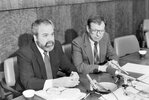By Iric Nathanson
George Latimer, St. Paul’s colorful and longest serving mayor died on Aug. 18, 2024 at the age of 89. During his last 10 years, Latimer lived in Midway at Episcopal Homes, where he was a familiar sight on the campus of the senior care agency across from the Fairview Ave. LRT station.
Latimer may have been a former mayor but everyone at Episcopal Homes – staff and residents alike – called him “George.” In his final years, even as he battled chronic illnesses, Latimer’s ebullient personality and sparkling wit never dimmed.
During his lifetime, the former mayor was never the subject of a biography that recounted his long career in St. Paul. But he did leave behind an unpublished monograph that provides a comprehensive account of Latimer’s time in city hall. The 500-page document, titled “The St. Paul Experiment, Initiatives of the Latimer administration,” was compiled by David Lanegran, Cynthia Seelhammer and Amy Walgrave.
In “The St. Paul Experiment,” Latimer was able to comment, with wry asides, on some of the key developments that occurred during his years as mayor from 1976 to 1990. He was particularly proud of the arts initiatives that occurred during those 14 years:
“If you believe as I do, that arts and artists are essential to a great city then you will agree that 1985 was a good year for St. Paul. Consider the way the year started. In January of 1985, the $45 million Ordway Music Theatre opened. If I were pressed to name one single building that altered downtown – or the city as a whole, it would surely be the Ordway. When I was asked to open the theater and give some comments, I said the city had little or nothing to do with the building of the Ordway. The mayor’s contribution had been to get out the way ‘so rich people could build a beautiful music hall.’ (The rich people, bless them, hate to be called that.)
“Skeptics might argue that a good bowling alley would be a more helpful contribution to downtown life than the flourishing of the arts. These are the same people who contend that the arts are a frill, somehow unconnected with what they see as ‘real’ life. My response is that I think it would be a great to have a bowling alley or two downtown. Indeed, a great city should have many nights of the type I observed a number of years ago. There was a night in Saint Paul when Pinky Zuckerman was playing the fiddle as only he can, at one end of our arts strip, one hour after Garrison Keillor had completed his very special and immensely popular radio show at the other end of the strip, and All-Star Wrestling was drawing its fans at the Civic Center behind the Ordway Theatre. All-Star Wrestling and great chamber music, cheek by jowl, so to speak, at the center of our city – that’s good stuff. That diversity is what urban centers have represented to millions of people all over the world. It is the very reason people want to be part of the city.”
In terms of bricks and mortar development, Latimer is remembered today for his efforts to spur the revitalization of Lowertown, the historic downtown district that had fallen on hard times before the former mayor took office. “Lowertown was intended to be the link with the past and the promise of the future,” Latimer observed in The St. Paul Experiment. “It was St. Paul’s unpolished gem. In the plans for redevelopment, we saw the vision for a new way of urban life. We approached the foundations and asked for funds to help us revitalize, with the goals of meeting the needs of the people, not the needs of the buildings. While it is true that the redevelopment is not yet complete, the vision is clear. There has been enough success that few can doubt how much of that vision is now real.”
Latimer was confident that Lowertown would realize its potential, but he recognized that not all city-sponsored projects that took shape on his watch would be equally successful. “Lowertown is one example of an attempt to celebrate and reaffirm one of the special places in Saint Paul. How well has Saint Paul done with that kind of celebration? Have we used our spaces in imaginative and harmonious ways? I think we have done marvelously well. There are, however, places I would definitely do over if I had the chance, such as the gray monolith exterior of Town Square.”
In summing up his approach to urban development, Latimer borrowed a quote from George Bernard Shaw who observed that, “‘The reasonable man tries to adapt himself to the world around him. The unreasonable man tries to adapt the world to himself. Therefore, all progress depends on the unreasonable man.’ If that is true, I am pleased to know that I have joined all those unreasonable people who have left their distinctive and individual marks on the exceptional places of St. Paul.”
“George was one of a kind,” said Dave Beal, business editor at the Pioneer Press during most of the Latimer years in the 1980s. “When I came to St. Paul in 1981, I initially saw him as a standard-issue liberal, a labor lawyer whose views often collided with those of corporate leaders and others in the business community. How wrong I was. He worked closely with businesses to forge private-public partnerships that brought new projects to the city’s long-slumbering downtown.
“That approach was representative of George’s ability to bring all kinds of interest groups and individuals together to run the city well. He gave the people of St. Paul a re-energized sense of pride and place and raised the city’s profile in the world beyond its borders. When it comes to leadership, George checked all the boxes.”


Comments
No comments on this item Please log in to comment by clicking here